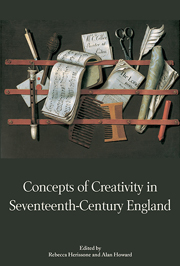Book contents
- Frontmatter
- Contents
- List of Illustrations
- List of Contributors
- Preface
- Introduction
- Creating to Order: Patronage and the Creative Act
- Creative Identity and the Role of Print Media
- 3 Author, Musician, Composer: Creator? Figuring Musical Creativity in Print at the Turn of the Seventeenth Century
- 4 Published Musical Variants and Creativity: An Overview of John Playford's Role as Editor
- Mapping Knowledge: The Visual Representation of Ideas
- Authorial Identity
- Imitation and Arrangement
- The Performer as Creator
- Bibliography
- Index
4 - Published Musical Variants and Creativity: An Overview of John Playford's Role as Editor
from Creative Identity and the Role of Print Media
Published online by Cambridge University Press: 05 March 2014
- Frontmatter
- Contents
- List of Illustrations
- List of Contributors
- Preface
- Introduction
- Creating to Order: Patronage and the Creative Act
- Creative Identity and the Role of Print Media
- 3 Author, Musician, Composer: Creator? Figuring Musical Creativity in Print at the Turn of the Seventeenth Century
- 4 Published Musical Variants and Creativity: An Overview of John Playford's Role as Editor
- Mapping Knowledge: The Visual Representation of Ideas
- Authorial Identity
- Imitation and Arrangement
- The Performer as Creator
- Bibliography
- Index
Summary
Recognition of the networks involved in the creation and production of printed texts has been the central focus of historians of the book since the 1950s. Fundamental to the production of the printed music book are, among others, printers, publishers, booksellers and binders, not to mention authors, composers and editors. As Kirsten Gibson describes in the previous chapter, scholarship has largely concentrated on issues relating to the author. Only recently have early editors of printed texts been taken into account to any significant extent, despite recognition that, in Robert Iliffe's words, the ‘manifestation of the “editor”’ is ‘intimately bound up with the appearance of the “author”’. Most recently, Susan Lewis Hammond has shed considerable light on the role of the early editor of printed music, focusing on Italian music published in early modern Germany. In placing the editor at the forefront of the dissemination of printed anthologies, Hammond, among others, has brought to our awareness the editor's presence in early printed music books, a presence that is situated between the initial creation of the musical text and its delivery to the public print market, and which can be traced back to the polyphonic music anthologies of Ottaviano Petrucci.
- Type
- Chapter
- Information
- Concepts of Creativity in Seventeenth-Century England , pp. 87 - 104Publisher: Boydell & BrewerPrint publication year: 2013

